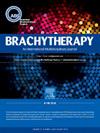2024 年 7 月 11 日星期四上午 10:30 - 11:30PP01 演讲时间:上午 10:30
IF 1.7
4区 医学
Q4 ONCOLOGY
引用次数: 0
摘要
目的 中/高危前列腺癌(PCa)需要高放射剂量(≥ 75 Gy EQD2)才能达到肿瘤控制效果。近距离放射治疗(BT)可提供陡峭的剂量梯度,从而提高肿瘤的剂量,同时将周围器官的剂量降至最低。因此,将体外射束放疗(EBRT)和近距离放射治疗(BT)相结合可能会减少胃肠道(GI)和泌尿生殖系统(GU)的毒性。这项多中心随机试验旨在比较单纯 EBRT 与 EBRT 加 BT 增效的毒性。我们在此介绍主要终点:3 年晚期消化道和泌尿生殖系统毒性。总生存期(OS)、生化无病生存期(bDFS)和无复发生存期(RFS)作为次要终点进行分析。材料与方法PCa患者,T1c-T3a期,N0,M0,PSA≤60 ug/l,Gleason≤8,被随机分配到以下治疗方案:单纯EBRT(35 × 2.5 mm)、EBRT+BT(35 × 2.5 mm)、EBRT+BT(35 × 2.5 mm)和EBRT+BT(35 × 2.5 mm):单用 EBRT(35 × 2.2 Gy)或 EBRT(20 × 2.2 Gy)+ BT 增效(HDR:1 × 13 Gy 或 PDR:24 × 1.27 Gy,间隔 2.2 小时)。两组患者的 EQD2 均为 79 Gy。EBRT 采用调强放疗。根据医生记录(临床记录表)和患者自评问卷,在基线期、治疗后前 3 年的每 6 个月以及治疗后 4 年和 5 年,采用 RTOG 晚期放射发病率评分标准对毒性进行评估。对于消化道和泌尿道毒性,以出现≥2级毒性的最高分和最早日期为依据进行分析。对于晚期消化道/胃肠道毒性≥2级的累积发生率,将无毒性死亡作为竞争事件,进行竞争风险回归分析。首先进行单变量回归分析,然后进行多变量回归分析,并对重要的单变量预后因素进行调整。年龄、PSA、Gleason、T期、风险分级、吸烟、尿流、激素治疗、糖尿病、腹部手术、消化道合并症、前列腺体积和基线时的总体消化道/GU均被视为候选预后因素。采用 Kaplan-Meier 方法和单变量/多变量 Cox 回归评估随机化后的 OS、bDFS 和 RFS。各组患者和肿瘤的基线特征以及基线毒性均十分均衡。3年累计≥2级消化道毒性发生率(图1a)为22%(EBRT+BT) vs 31%(EBRT),单变量无统计学差异(HR 0.67; 95% CI 0.41 - 1.12; p=0.129)。由于根据单变量分析,没有任何因素似乎对≥2级消化道毒性有预后价值,因此没有进行多变量分析。≥2级消化道毒性的3年累积发生率(图1b)为43%(EBRT+BT)vs 29%(EBRT),单变量分析(HR 1.49; 95% CI 0.98 - 2.27; p=0.064)和糖尿病(是/否)调整后的多变量分析(HR 1.44; 95% CI 0.94 - 2.20; p=0.090)均无统计学差异。3年后,EBRT+BT vs EBRT的OS分别为95% vs 98%,bDFS为97% vs 98%,RFS为97% vs 97%。结论 在这项多中心随机试验中,观察到晚期消化道毒性≥2级的减少和晚期GU毒性≥2级的增加未达到统计学意义。本文章由计算机程序翻译,如有差异,请以英文原文为准。
Thursday, July 11, 202410:30 AM - 11:30 AMPPP01 Presentation Time: 10:30 AM
Purpose
A high radiation dose (≥ 75 Gy EQD2) is required to achieve tumor control in intermediate / high-risk prostate cancer (PCa). Brachytherapy (BT) provides a steep dose gradient, resulting in a higher dose to the tumor while minimizing dose to surrounding organs. Therefore, a combination of external beam radiotherapy (EBRT) and a BT boost may potentially result in less gastrointestinal (GI) and genitourinary (GU) toxicity. This multicenter, randomized trial was designed to compare the toxicity of EBRT alone with that of EBRT plus a BT boost. Here we present the primary endpoint: the 3 years late GI and GU toxicity. Overall survival (OS), biochemical disease-free survival (bDFS) and relapse-free survival (RFS) were analyzed as secondary endpoints.
Materials and Methods
Patients with PCa, stage T1c-T3a, N0, M0, PSA ≤ 60 ug/l and Gleason ≤ 8, were randomized to: EBRT alone (35 × 2.2 Gy) or EBRT (20 × 2.2 Gy) + BT boost (HDR: 1 × 13 Gy or PDR: 24 × 1.27 Gy, 2.2 hour interval). Both arms received an EQD2 of 79 Gy. EBRT was given using intensity modulated radiotherapy. The toxicity was assessed with the RTOG Late Radiation Morbidity Scoring criteria from both physicians’ records (clinical record form) and patients’ self-assessment questionnaires, at baseline, every 6 months for the first 3 years, and at 4 and 5 years post treatment. For both GI and GU toxicity, the highest score and the earliest date corresponding to the occurrence of grade ≥2 toxicity was registered for analysis. For the cumulative incidence of grade ≥ 2 late GI / GU toxicity, a competing risk regression analysis was performed considering death without toxicity as the competing event. First a univariate regression analysis was performed, followed by a multivariate regression analysis with adjustment for significant univariable prognostic factors. With age, PSA, Gleason, T-stage, risk classification, smoking, urinary flow, hormonal therapy, diabetes, abdominal surgery, GI comorbidity, prostate volume and overall GI/GU at baseline considered as candidate prognostic factors. OS, bDFS and RFS were assessed from randomization using the Kaplan-Meier method and univariate / multivariate Cox regression.
Results
From March 2013 to March 2019, 196 evaluable patients were enrolled. Baseline patient and tumor characteristics as well as baseline toxicity were well balanced between arms. The 3-year cumulative incidence of grade ≥ 2 GI toxicity (Fig. 1a) was 22% (EBRT+BT) vs 31% (EBRT), not statistically different in univariate (HR 0.67; 95% CI 0.41 - 1.12; p=0.129). Since no factor seem to have prognostic value for grade ≥ 2 GI toxicity based on the univariate analysis, no multivariate analysis was conducted. The 3-year cumulative incidence of grade ≥ 2 GU toxicity (Fig. 1b) was 43% (EBRT+BT) vs 29% (EBRT), not statistically different in univariate (HR 1.49; 95% CI 0.98 - 2.27; p=0.064) nor multivariate analysis adjusted for diabetes mellitus (yes/no) (HR 1.44; 95% CI 0.94 - 2.20; p=0.090). At 3 years, OS was 95% vs 98%, bDFS 97% vs 98% and RFS 97% vs 97%, in EBRT+BT vs EBRT, respectively. No significant differences between the arms were found.
Conclusions
In this multicenter, randomized trial that investigated the added value of a BT boost compared to EBRT alone, the observed decrease in grade ≥ 2 late GI and increase in grade ≥ 2 late GU toxicity did not reach statistical significance.
求助全文
通过发布文献求助,成功后即可免费获取论文全文。
去求助
来源期刊

Brachytherapy
医学-核医学
CiteScore
3.40
自引率
21.10%
发文量
119
审稿时长
9.1 weeks
期刊介绍:
Brachytherapy is an international and multidisciplinary journal that publishes original peer-reviewed articles and selected reviews on the techniques and clinical applications of interstitial and intracavitary radiation in the management of cancers. Laboratory and experimental research relevant to clinical practice is also included. Related disciplines include medical physics, medical oncology, and radiation oncology and radiology. Brachytherapy publishes technical advances, original articles, reviews, and point/counterpoint on controversial issues. Original articles that address any aspect of brachytherapy are invited. Letters to the Editor-in-Chief are encouraged.
 求助内容:
求助内容: 应助结果提醒方式:
应助结果提醒方式:


